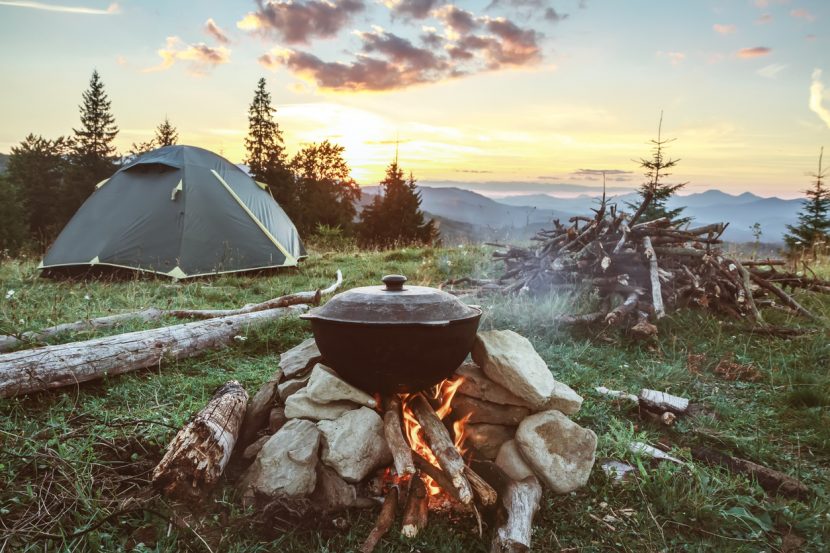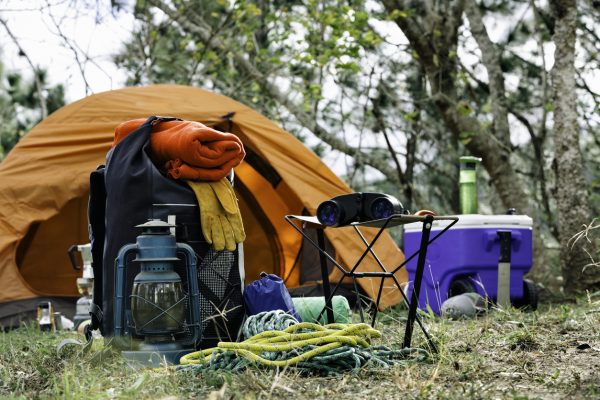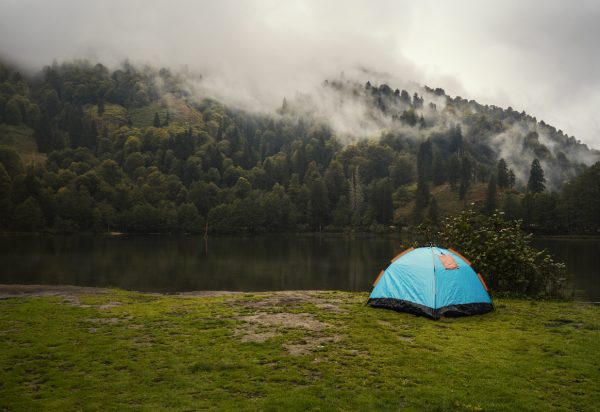16 Things You Really Need to Do to Create a Perfect Bug Out Camp

Bugging out is a complex operation. It takes much more than just throwing a bug out bag together, hopping in the car and taking off to “somewhere in the wild.”
You’ve got to have a comprehensive plan, including where you are going, how you’re going to get there, even if the streets are blocked, and how you are going to survive once you arrive.
Ideally, we’d all be able to go out and buy that cabin in the woods that we want to have. But for most of us, that’s just not possible.
The cost of such a retreat puts it in the category of something we might dream of, rather than something we might actually aspire to. Short of winning the lottery or some other miracle, that’s where it’s going to stay.

But that doesn’t negate our need for a bug out destination that we can take our family to. It merely makes things a bit more challenging. We still need a bug out camp to go to in times of emergency, even if we can’t own our very own bug out retreat.
The idea then, is to have a destination in mind, along with everything in place, so that we can have someplace to go to, when and if the time comes that we need to. So, let’s break that down:
The Location Itself
To start with, you have to find a location that you can use to establish a bug out camp. This is either going to have to be public land or land that is owned by someone who will allow you to use it. I wouldn’t recommend planning on using land that belongs to some farmer that you don’t know, as they probably wouldn’t be all that happy to loan it to you.
1. Water
Wherever you go, you’re going to need to have a good, reliable source of water, probably a lake or river. Don’t plan on that water being clean enough to drink though, you need to make sure that you have some means of purifying that water, so that it will be safe for you and your family.
2. Firewood
Chances are, the weather isn’t going to be cooperative, when you have to bug out. So you’d better plan on having to cut wood and burn it through the winter.
Ideally, your camp will have a lot of deadfall laying around that you can use. Not only will that save you from having to fell the trees, but it will already be dry, making it easier to burn.
3. Sewage
No, I’m not expecting there to be an existing sewage system in place, which you can plug your port-a-potty in. Rather, you need to look around and ensure that it will be possible to dig a hole and build an outhouse. If the ground is hard and rocky, you’re going to have a hard time doing much digging.
4. Soil
Speaking of the ground, if your bug out looks like it’s going to be a long-term affair, you should try to get seed in the ground as soon as possible, so that you can feed your family.
What does the soil look like? Is it nice and rich? Does it look like something you’d want in your garden? If not, what can you do between now and then to either improve it or make sure you have the necessary ingredients to improve it?
5. Food Sources
No matter how much food you stockpile and how much you bring with you, you’ll eventually run out. How’s the hunting and fishing where you’re planning on going? Are there edible plants already growing in the area? If not, can you secretly plant some fruit trees and edible plants now, so that they can go wild and be producing food when you get there?
6. Hidden
I’ve always believed in having a bug out retreat somewhere that people aren’t likely to find it. You don’t want to be sitting on the top of the mountain or by the side of the road. Rather, you want someplace you can go to, where people are going to have to work hard to find you. Hopefully, nobody will be able to find you.

But even though it is hidden, you need it to be accessible, at least to you. Whether that means having four-wheel-drive vehicles or packing things in on horseback is up to you. Somehow or other, you’re going to have to get your family and your possessions in there, so be sure that you can.
7. Defensible
Your location should also be someplace that you can defend. Ideally, there will be rocks around, which you can use as a basic perimeter. Having obstacles which make it hard for people to approach from some directions is useful as well. But you absolutely don’t want others to have a vantage point where they can observe you and snipe at you from afar.
8. Storage
Finally, the last thing you need to consider, for the place itself, is what you have available to you in the way of storage. Obviously, if you don’t own the land, you can’t bring in a 40 foot shipping container and set it up for your storage.
The question isn’t so much what storage is there, on site, as what storage is available nearby. Is there a small town, where you can rent one of those storage units? If there is, you can keep most of your gear and supplies nearby your bug out retreat, where it will be easy to move in, when the time comes.
Your Gear and Supplies
Of course, the place is only the starting point. If you’re going to have to leave your home and bug out to a remote location, you’re going to need a lot more than your bug out bag can hold. Ideally, you will have that equipment and supplies pre-located, in storage, somewhere near your ultimate destination.
9. Shelter
The single most important thing to consider is what you are going to do for shelter. Even if your long-term plan is to build a log cabin to live in, you’re going to need a tent, yurt, teepee or some other temporary shelter for your family to live in, until you get that log cabin built.
I’d recommend having something heavy-duty and strong, as it might take quite a while to actually have a livable log cabin completed.
10. Water Purification
We already talked about the need for there to be a water source nearby where you are going to set up your bug out camp. You also have to have some sort of water purification plan, so that you can purify that water and make it drinkable. Never assume water is safe to drink; it probably isn’t.

Keep in mind here that you’re going to need something that will work long-term. Most water filter systems are only good for a limited number of gallons. What are you going to do when the filters are clogged? How many filters are you going to have or are you going to have filters that are back-flushable, so that they last forever?
11. Food
We all know that we need food for survival and most of us started our disaster preparedness work by stockpiling food. But where is that food? If it is all at your home, how are you going to get it to your bug out camp?
Perhaps it would be better to create a cache, either buried on site or in the above mentioned rented storage space, with enough food to keep your family going for a while.
But that’s not the only food you are going to need, especially if you end up living in your new location semi-permanently. You’re going to need to be growing and harvesting food locally. So you want to make sure that you have seed, fertilizer, other gardening chemicals and gardening tools to use.
12. Tools
Speaking of tools, pretty much any bug out camp is going to require you building things and digging holes. So you’d better make sure that you have something bigger than your tomahawk and wire saw to work with. Stash some good, full-size tools with the rest of your cache, so that they are there when you need them.
Think through what you would need to build a more permanent shelter and make sure you have all those tools.
When You Get There
Of course, once you actually get to your bug out camp, you’re going to have to make everything work. It’s going to seem like there are a million things that have to be done and they’ll all need to be done right away. What’s the priority here?
In a way, this is no different than setting up camp any other time. That means your priorities are going to be setting up your shelter and starting a fire. You’ll need those, just to get through your first night. So don’t waste time on those, taking care of other things.
13. Security
One of your big concerns is going to be local security. How do you know that there’s nobody else camping nearby, who had the same idea as you? You’re going to have to scout out the area and meet any neighbors that you might have.
If they are there, setting up their bug out camp, they’re probably not going to be a problem and might even be an asset if you can work together. But if they’re there without any of what they need to have to survive, they’re going to be a problem.
Scouting can wait till the next day; but while you’re setting up camp, make sure you have one person acting as a lookout, watching for any danger. You’re going to have to have that lookout pretty much all the time, until things settle back to normal.
The next part, which you should start on the next day, is establishing your defenses. Remember those rocks I talked about? Now’s the time to get them into position and make sure that they are usable firing positions. Drag some dead branches into the gaps, so you can create barriers and make sure you have a plan for defending yourself.
14. Food, once Again
Yes, I’m back on the subject of food again. You’re going to need a lot of it to keep your family going; so you want to start working on that as soon as you can.
Start working on harvesting food from nature, as well as planting your own. If you hunt, do it a little ways away from your camp, both to avoid attracting anyone with your noise and to leave the animals living closer in for the hard times.
15. More Permanent Shelter
There’s no way I can tell you what you’re going to need for shelter or how to build it. A lot will depend on where you are, how harsh the climate is and what materials you have to work with. But you’ll need to get started on a more permanent shelter as soon as possible, unless you think you’re only going to be there a few months.
Tents are great, but they won’t last long, when you’re using them every day. You’ll want to have something better, before your tent can tear. Besides, you’re going to want the additional room that a larger shelter can provide.
16. Dig an Outhouse
Yes, I mentioned this one before too; but now it’s time to do something about it. An outhouse is an important part of preventing the spread of disease.
Make sure that you dig it at least 100 feet from any water sources and that it is not uphill from them. You don’t want bacteria from your outhouse getting into your water source.
Speaking of protecting your water source, bathing in the river or lake isn’t a good idea. Just like bacteria from your outhouse can get into your water source, you can end up with bacteria from your bodies getting into it.
Even if you have your bathing area downstream of where you draw your water, what about others who are farther downstream of your camp? Better to set up some sort of bathing area and haul water to it. It’s extra work, but it will help protect your family’s health.
